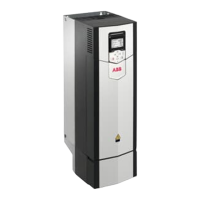delays caused by the filtering can be compensated by 87.27. When the axes have
been synchronized, it is also possible to activate a phasing relative or superimposed
move of the follower axis.
With a master encoder (encoder 1 or 2), also the setting of increments per revolution
will affect the gear-in ratio. For adjustments, see parameter 86.11, 86.12 and 87.10.
The actual gear-in ratio between the master reference and axis position is based
on their raw position values.
The diagram below is an overview of master reference handling. A more detailed
diagram is presented on page 643.
AI 1/2
FB A Ref 1/2
D2D Master/Axis
Encoder 1/2
Virtual master
87.14/15 Feed constant
Phasing relative
Superimposed
86.18/19
Modulo range
+ 88.65 Pos ref sync
87.02 Master position reference ungeared
87.03 Master position reference geared
+
87.15/16
Master axis
modulo range
87.30 External sync velocity correction
87.31 External sync ratio
87.32 Enable PI sync correction
85.01 PI control output
87.35/36
Gear in ratio
d
dt
88.66 Velocity ref sync
87.04 Master velocity reference
d
dt
■
Virtual master
With the virtual master, a physical master source (eg. master encoder) is not needed
for synchronized operation. The follower will generate its own master reference
by converting the velocity reference into a position reference by integration. The
virtual master has its own settings for the velocity profile, including jogging and
stopping profiles.
• 87.50 Virtual master velocity ref
• 87.51 Virtual master max velocity
• 87.52 Virtual master jog velocity ref
• 87.53 Virtual master ramp time
• 87.54 Virtual master stop ramp time
The virtual master can be started and stopped by its own command bits in the
control word. The sources of these bits are selected by
• 74.47 Virtual master run sel
• 74.48 Virtual master jog forward sel
• 74.49 Virtual master jog reverse sel
• 74.50 Virtual master stop sel.
52 Position control program features

